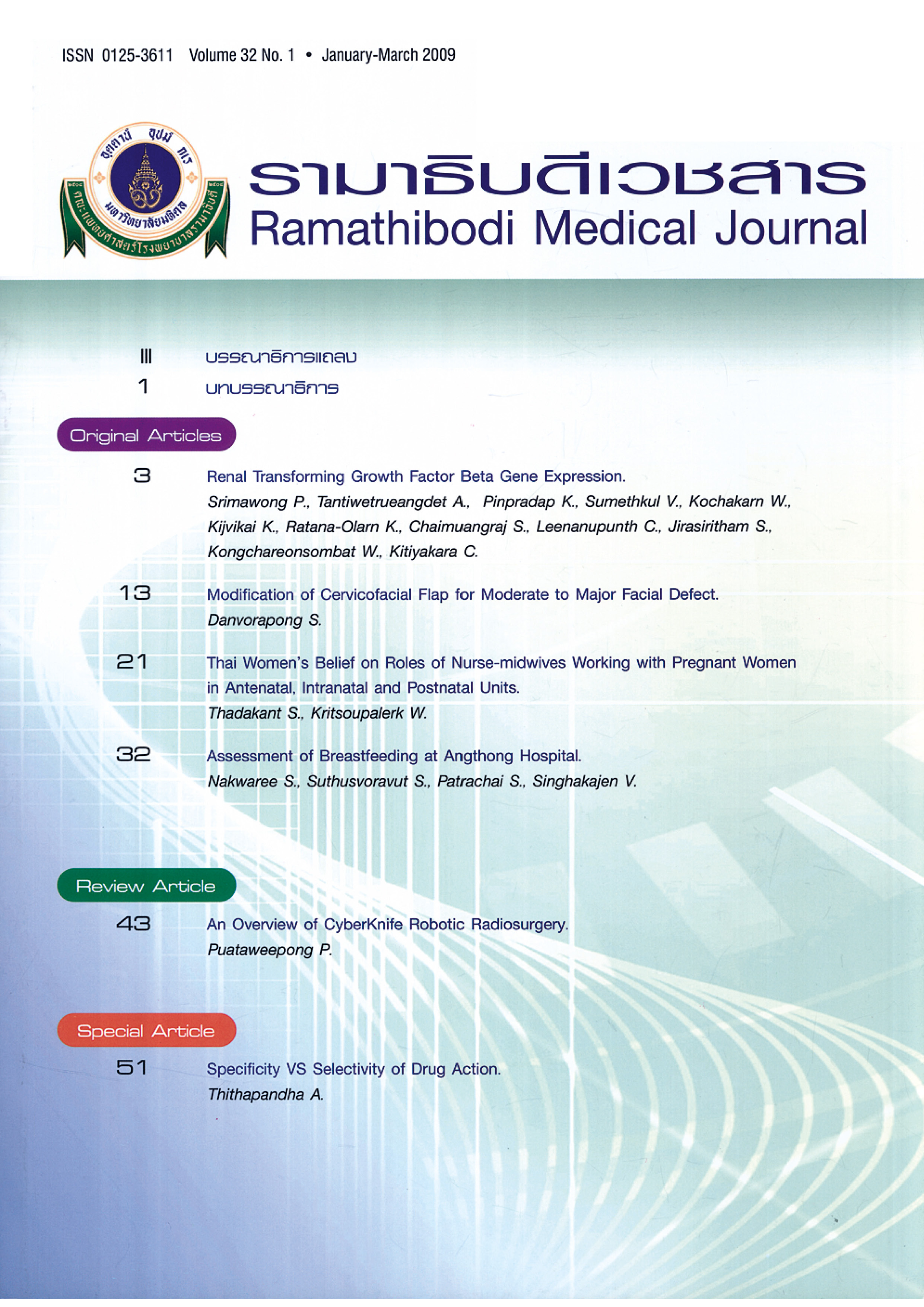Renal Transforming Growth Factor Beta Gene Expression
Keywords:
Fibrosis, Kidney, Renal failure, Transforming growth factor beta, Real time PCRAbstract
Background: Fibrosis in the renal biopsy is associated with poor long term outcome in many kidney diseases. However, fibrosis occurs at a late stage when the kidney is irreversibly damaged. Molecular biology techniques are currently being investigated to identify early prognostic markers in kidney diseases. Reverse transcriptase real-time PCR (RT-qPCR) is a highly sensitive technique capable of detecting small changes in gene expression, Transforming growth factor-1 (TGF-
1) is a key mediator of fibrosis and is expected to be increased in damaged tissues. This is a pilot study to investigate the feasibility of the using RT-qPCR to study gene expression of TGF-31 in human kidney tissues.
Methods: RNA was extracted from normal and diseased human kidneys with fibrosis and reverse transcribed. TGF-1 gene expression was studied by multiplex RT-qPCR using cyclophilin A as a housekeeping gene. Relative gene expression was calculated from 2-DDCT method.
Results: The expression TGF-1 in three different areas of the same kidney were similar The expression of TGF-b
1 was 4-5 fold higher in disease kidney tissues compared to normal (p < 0.001).
Summary: TGF-P1 gene expression can be measured from human kidney using RT-qPCR. There are minimal effects of tissue sampling on gene expression levels, hence tissue obtained from a kidney biopsy should be representative of the whole kidney cortex. The expression of TGF-1 is higher in fibrotic kidneys. Future studies are necessary to determine if the TGF-
1 gene expression markers can predict disease progression.
References
Levey AS, Eckardt KU, Tsukamoto Y, Levin A, Coresh J, Rossert J, et al. Definition and classification of chronic kidney disease: a position statement from Kidney Disease: Improving Global Outcomes (KDIGO). Kidney Int. 2005;67(6):2089-2100. doi:10.1111/j.1523-1755.2005.00365.x.
Striker LJ, Striker GE. Windows on renal biopsy interpretation: does mRNA analysis represent a new gold standard?. J Am Soc Nephrol. 2003;14(4):1096-1098. doi:10.1097/01.asn.0000060865.30249.40.
Eikmans M, Ijpelaar DH, Baelde HJ, de Heer E, Bruijn JA. The use of extracellular matrix probes and extracellular matrix-related probes for assessing diagnosis and prognosis in renal diseases. Curr Opin Nephrol Hypertens. 2004;13(6):641-647. doi:10.1097/00041552-200411000-00010.
Henger A, Schmid H, Kretzler M. Gene expression analysis of human renal biopsies: recent developments towards molecular diagnosis of kidney disease. Curr Opin Nephrol Hypertens. 2004;13(3):313-318. doi:10.1097/00041552-200405000-00008.
Kubista M, Andrade JM, Bengtsson M, et al. The real-time polymerase chain reaction. Mol Aspects Med. 2006;27(2-3):95-125. doi:10.1016/j.mam.2005.12.007.
Saiki RK, Scharf S, Faloona F, Mullis KB, Horn GT, Erlich HA, et al. Enzymatic amplification of beta-globin genomic sequences and restriction site analysis for diagnosis of sickle cell anemia. Science. 1985;230(4732):1350-1354. doi:10.1126/science.2999980.
Ziyadeh FN. Mediators of diabetic renal disease: the case for tgf-Beta as the major mediator. J Am Soc Nephrol. 2004;15 Suppl 1:S55-S57. doi:10.1097/01.asn.0000093460.24823.5b.
Eikmans M, Baelde HJ, Hagen EC, Paul LC, Eilers PH, De Heer E, et al. Renal mRNA levels as prognostic tools in kidney diseases. J Am Soc Nephrol. 2003;14(4):899-907. doi:10.1097/01.asn.0000056611.92730.7b.
Bergsma DJ, Eder C, Gross M, Kersten H, Sylvester D, Appelbaum E, et al, The cyclophilin multigene family of peptidyl-prolyl isomerases. Characterization of three separate human isoforms. J Biol Chem. 1991;266(34):23204-23214.
Koletsky AJ, Harding MW, Handschumacher RE. Cyclophilin: distribution and variant properties in normal and neoplastic tissues. J Immunol. 1986;137(3):1054-1059.
Ryffel B, Woerly G, Greiner B, Haendler B, Mihatsch MJ, Foxwell BM. Distribution of the cyclosporine binding protein cyclophilin in human tissues. Immunology. 1991;72(3):399-404.
Schmid H, Cohen CD, Henger A, Irrgang S, Schlöndorff D, Kretzler M. Validation of endogenous controls for gene expression analysis in microdissected human renal biopsies. Kidney Int. 2003;64(1):356-360. doi:10.1046/j.1523-1755.2003.00074.x.
Koop K, Bakker RC, Eikmans M, Baelde HJ, de Heer E, Paul LC, et al. Differentiation between chronic rejection and chronic cyclosporine toxicity by analysis of renal cortical mRNA. Kidney Int. 2004;66(5):2038-2046. doi:10.1111/j.1523-1755.2004.00976.x.
Applied Biosystems. User Bulletin #2 ABI Prism 7700 Sequence Detection System. Available from: http://tools.thermofisher.com/content/sfs/manuals/cms_040980.pdf. Published December 11, 1997. Updated October 2001.
Livak KJ, Schmittgen TD. Analysis of relative gene expression data using real-time quantitative PCR and the 2(-Delta Delta C(T)) Method. Methods. 2001;25(4):402-408. doi:10.1006/meth.2001.1262.













